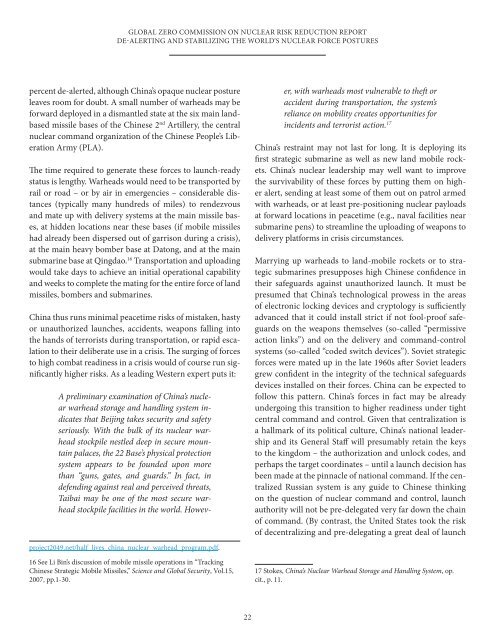global_zero_commission_on_nuclear_risk_reduction_report
global_zero_commission_on_nuclear_risk_reduction_report
global_zero_commission_on_nuclear_risk_reduction_report
Create successful ePaper yourself
Turn your PDF publications into a flip-book with our unique Google optimized e-Paper software.
GLOBAL ZERO COMMISSION ON NUCLEAR RISK REDUCTION REPORTDE-ALERTING AND STABILIZING THE WORLD’S NUCLEAR FORCE POSTURESpercent de-alerted, although China’s opaque <strong>nuclear</strong> postureleaves room for doubt. A small number of warheads may beforward deployed in a dismantled state at the six main landbasedmissile bases of the Chinese 2 nd Artillery, the central<strong>nuclear</strong> command organizati<strong>on</strong> of the Chinese People’s Liberati<strong>on</strong>Army (PLA).The time required to generate these forces to launch-readystatus is lengthy. Warheads would need to be transported byrail or road – or by air in emergencies – c<strong>on</strong>siderable distances(typically many hundreds of miles) to rendezvousand mate up with delivery systems at the main missile bases,at hidden locati<strong>on</strong>s near these bases (if mobile missileshad already been dispersed out of garris<strong>on</strong> during a crisis),at the main heavy bomber base at Dat<strong>on</strong>g, and at the mainsubmarine base at Qingdao. 16 Transportati<strong>on</strong> and uploadingwould take days to achieve an initial operati<strong>on</strong>al capabilityand weeks to complete the mating for the entire force of landmissiles, bombers and submarines.China thus runs minimal peacetime <strong>risk</strong>s of mistaken, hastyor unauthorized launches, accidents, weap<strong>on</strong>s falling intothe hands of terrorists during transportati<strong>on</strong>, or rapid escalati<strong>on</strong>to their deliberate use in a crisis. The surging of forcesto high combat readiness in a crisis would of course run significantlyhigher <strong>risk</strong>s. As a leading Western expert puts it:er, with warheads most vulnerable to theft oraccident during transportati<strong>on</strong>, the system’sreliance <strong>on</strong> mobility creates opportunities forincidents and terrorist acti<strong>on</strong>. 17China’s restraint may not last for l<strong>on</strong>g. It is deploying itsfirst strategic submarine as well as new land mobile rockets.China’s <strong>nuclear</strong> leadership may well want to improvethe survivability of these forces by putting them <strong>on</strong> higheralert, sending at least some of them out <strong>on</strong> patrol armedwith warheads, or at least pre-positi<strong>on</strong>ing <strong>nuclear</strong> payloadsat forward locati<strong>on</strong>s in peacetime (e.g., naval facilities nearsubmarine pens) to streamline the uploading of weap<strong>on</strong>s todelivery platforms in crisis circumstances.Marrying up warheads to land-mobile rockets or to strategicsubmarines presupposes high Chinese c<strong>on</strong>fidence intheir safeguards against unauthorized launch. It must bepresumed that China’s technological prowess in the areasof electr<strong>on</strong>ic locking devices and cryptology is sufficientlyadvanced that it could install strict if not fool-proof safeguards<strong>on</strong> the weap<strong>on</strong>s themselves (so-called “permissiveacti<strong>on</strong> links”) and <strong>on</strong> the delivery and command-c<strong>on</strong>trolsystems (so-called “coded switch devices”). Soviet strategicforces were mated up in the late 1960s after Soviet leadersgrew c<strong>on</strong>fident in the integrity of the technical safeguardsdevices installed <strong>on</strong> their forces. China can be expected tofollow this pattern. China’s forces in fact may be alreadyundergoing this transiti<strong>on</strong> to higher readiness under tightcentral command and c<strong>on</strong>trol. Given that centralizati<strong>on</strong> isa hallmark of its political culture, China’s nati<strong>on</strong>al leadershipand its General Staff will presumably retain the keysto the kingdom – the authorizati<strong>on</strong> and unlock codes, andperhaps the target coordinates – until a launch decisi<strong>on</strong> hasbeen made at the pinnacle of nati<strong>on</strong>al command. If the centralizedRussian system is any guide to Chinese thinking<strong>on</strong> the questi<strong>on</strong> of <strong>nuclear</strong> command and c<strong>on</strong>trol, launchauthority will not be pre-delegated very far down the chainof command. (By c<strong>on</strong>trast, the United States took the <strong>risk</strong>of decentralizing and pre-delegating a great deal of launchA preliminary examinati<strong>on</strong> of China’s <strong>nuclear</strong>warhead storage and handling system indicatesthat Beijing takes security and safetyseriously. With the bulk of its <strong>nuclear</strong> warheadstockpile nestled deep in secure mountainpalaces, the 22 Base’s physical protecti<strong>on</strong>system appears to be founded up<strong>on</strong> morethan “guns, gates, and guards.” In fact, indefending against real and perceived threats,Taibai may be <strong>on</strong>e of the most secure warheadstockpile facilities in the world. Howevproject2049.net/half_lives_china_<strong>nuclear</strong>_warhead_program.pdf.16 See Li Bin’s discussi<strong>on</strong> of mobile missile operati<strong>on</strong>s in “TrackingChinese Strategic Mobile Missiles,” Science and Global Security, Vol.15,2007, pp.1-30.17 Stokes, China’s Nuclear Warhead Storage and Handling System, op.cit., p. 11.22


